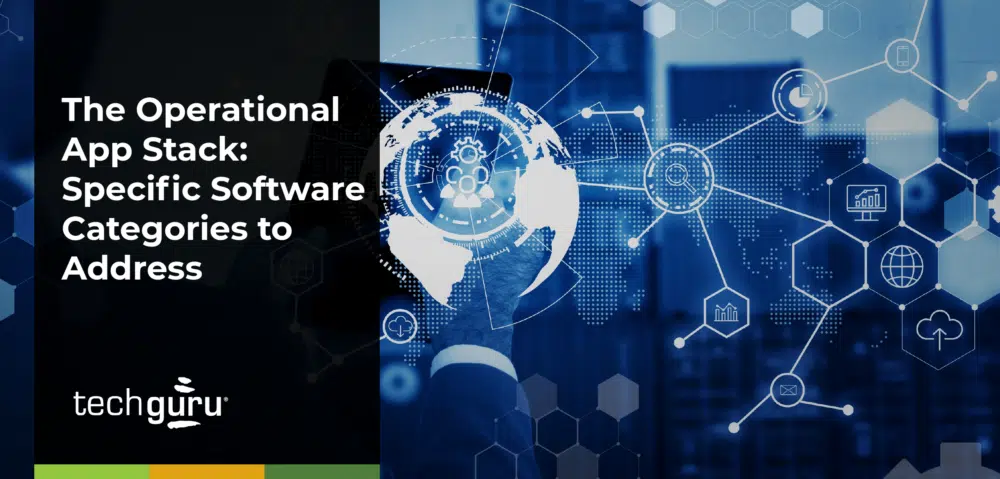
An operational app stack for an accounting firm is like a perfectly curated playlist. Each software application is a song with its unique style and sound, but combined creates a harmonious and engaging experience. With an operational app stack, an accounting firm can seamlessly move from one task to the next, improving communication and streamlining workflow. Just like a well-crafted playlist, an operational app stack can elevate an accounting firm’s work and help it perform at its best.
When determining which programs to include in your operational app stack, there are five categories to which you should pay particular attention. Each category acknowledges different functional aspects of your firm that can be strengthened by leveraging technology.
5 Specific Categories to Address with Your Operational App Stack
A robust operational app stack can help accounting firms in many ways, such as automating tedious tasks, providing real-time data and insights, improving communication and collaboration, meeting industry standards, and providing a seamless user experience. Accounting firms can improve their operations and achieve greater success by carefully choosing suitable applications and integrating them into a cohesive stack.
These applications must seamlessly integrate. That’s why discussing the firm’s IT infrastructure needs with an expert before investing can be highly beneficial.
They can work with a firm to assess technology needs and make recommendations. They will walk their clients through every integration phase and ensure that everything goes smoothly to reduce downtime.
Many experts will work with the firm’s staff to ensure they have all the training and skills they need to operate every facet of the firm’s operational app stack. Here are the categories to address when assessing a firm’s operational app stack.
1. Enterprise Software
Enterprise software is an industry-specific line of business software. Ideally, this software should be cloud and browser-based and feature an open API that integrates with an organization’s other best-in-class platforms.
When selecting enterprise software, ensure client training is provided as part of the integration. Also, remember that while it will likely be the most expensive software, it will give the greatest return on investment.
Organizations that deploy this software benefit from automated processes that reduce the need for additional workers, as enterprise software can complete tasks equivalent to multiple employees.
Think of an organization’s enterprise software as the hub; every other aspect of its tech stack is the spokes. If a client is on a legacy enterprise application, it’s worth considering upgrades or an alternative to the current software. However, changing this application will also be the most time-consuming and cost-intensive.
Before making any changes, consult with the experts. They can assist with more seamless integration when helping clients make a move related to their enterprise software. The first thing they will evaluate is whether their software is working for them or whether they are working for it.
2. Billing/Contract Management
Like practice management software, billing and contract management software is how organizations keep track of what work staff has done and what clients owe for services rendered. It may or may not be part of the enterprise software and should provide insights into profitability productivity.
If this functionality is paramount for operations, ensure that the organization’s enterprise software offers billing and contract management. Or speak to an expert about integrating it into the firm’s IT infrastructure.
3. Bookkeeping/Accounting
Ideally, clients should use either QuickBooks Online or Xero for their bookkeeping and accounting software. At Tech Guru, they use Xero because it integrates with their enterprise software for ease of billing.
If a client is not on cloud-based accounting software, this might be an excellent opportunity to lead the charge and help them make the transition.
It will empower them to take advantage of the incredible portfolio of apps that integrates well and can help clients better run their businesses. These apps include dashboarding, payments, inventory management, forecasting, and many more.
4. Expense Management
Expense management software is an example of back-office automation that allows them to automate and streamline their workflows. The experts at Tech Guru recommend Expensify, but there are others out there to choose from that work equally as well.
Consider what things clients do manually. What are the most tedious, error-prone, or redundant tasks? For many, the answer is expense management.
Controllers emailing staff and chasing them down for invoices and receipts is not an efficient use of time. Expense management software does the work, and Expensify integrates seamlessly with Xero.
5. Business Analytics, Dashboarding, & Scorecards
Companies produce mountains of data every day. Collecting, storing, and analyzing this data requires information systems that make it easy to access the information when needed. These software solutions must also keep data secure.
A good data analytics tool is also necessary to help leaders make business decisions. Data can be pulled from multiple sources, especially if they are already on the cloud.
For firms that don’t already have a data analytics platform, consider a data analytics expert to make sense of the firm’s data and help drive business decisions. Popular data analytic platforms include:
- Tableau
- Domo
- Microsoft BI (business intelligence)
Addressing Your Operational App Stack Needs Requires the Gurus
At Tech Guru, we help accounting firms like yours ensure that you have the operational app stack you need to perform your daily workflows. We know what systems and platforms integrate well with your existing infrastructure and can recommend which apps will work best to streamline operations.
We can help you make the best investment into your application stack to improve efficiencies and drive growth. Our friendly professionals will work with you to make sure that every member of your team has access to the information they need and knows how to use the technology available.
Assess your firm’s tech stack with our Technology Check-Up. We can help you assess your technology needs and where you should prioritize investment into your IT infrastructure.
